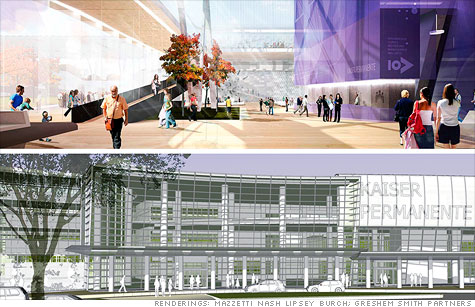Search News

Two finalists in Kaiser's contest to design the small hospital of the future emphasize lots of natural light and green energy. A pavillion (top) offers healthy living courses in cooking and exercise.
FORTUNE -- In his book Anatomy of an Illness, the late political pundit Norman Cousins concluded, "A hospital is no place for a person who is seriously ill." Suffering from a connective-tissue disease, Cousins noted during his hospital stay how easily infections spread and the unnecessary testing that had patients being awakened at all hours for blood samples. He checked himself out and into a hotel and, with a physician, healed himself by getting rest, taking vitamin C, and watching Marx Brothers films.
That was nearly half a century ago, yet not all that much has changed. Most of America's medical facilities were built in the 1950s and are what architects call "deep" buildings: huge, maze-like structures with little or no natural light, windows that don't open, and inefficient heating and cooling. U.S. facilities are some 2.5 times more energy intensive than European hospitals. Infections are still the No. 1 cause of death in U.S. hospitals.
Kaiser Permanente, a nonprofit with $4.8 billion a year in revenue that insures and treats 8.8 million patients, has set out to design the hospital of the 21st century, planning to spend billions a year to meet the challenge. Kaiser wants healthier, more energy-efficient facilities set up in a way that encourages what it calls "team care" rather than the current pay-for-service system, under which, it says, 10% of patients account for 80% of costs. By providing team care, which coordinates treatment among a patient's doctors and nurses and includes preventive care, Kaiser says the U.S. could cut events like heart attacks and kidney failure by half.
In some instances, Kaiser believes that a small neighborhood hospital would be best suited to team care by making it easier for its patients to visit more often, especially those in rural areas who don't have easy access to big facilities. Small hospitals integrated into neighborhoods will also make it easier for workers to keep on top of patients to foster healthy living and provide preventive care.
To gather best-in-class concepts, Kaiser earlier this year held a design contest: "Small Hospital, Big Idea." In June it announced three finalists. The designs incorporate tech that helps improve the doctor-patient relationship, cuts down on medical errors, and better manages patients with chronic diseases. In one design, conversations between doctor and patient are recorded. A family member can later watch the video on a large touchscreen on the wall to understand the doctor's orders.
The finalists included soaring atriums or other sources of natural light -- which some studies suggest hasten healing -- and windows that open. Robin Guenther, a principal at the architecture firm Perkins & Will, one of the finalists, says rooftop solar, insulation, and other efficiency measures could reduce a hospital's energy use by 30%. Says John Kouletsis, Kaiser's vice president of facilities planning: "Smart hospitals are not going to solve the health care crisis, but they could have a dramatic impact on lowering costs and improving health."
The only thing missing: Marx Brothers films.